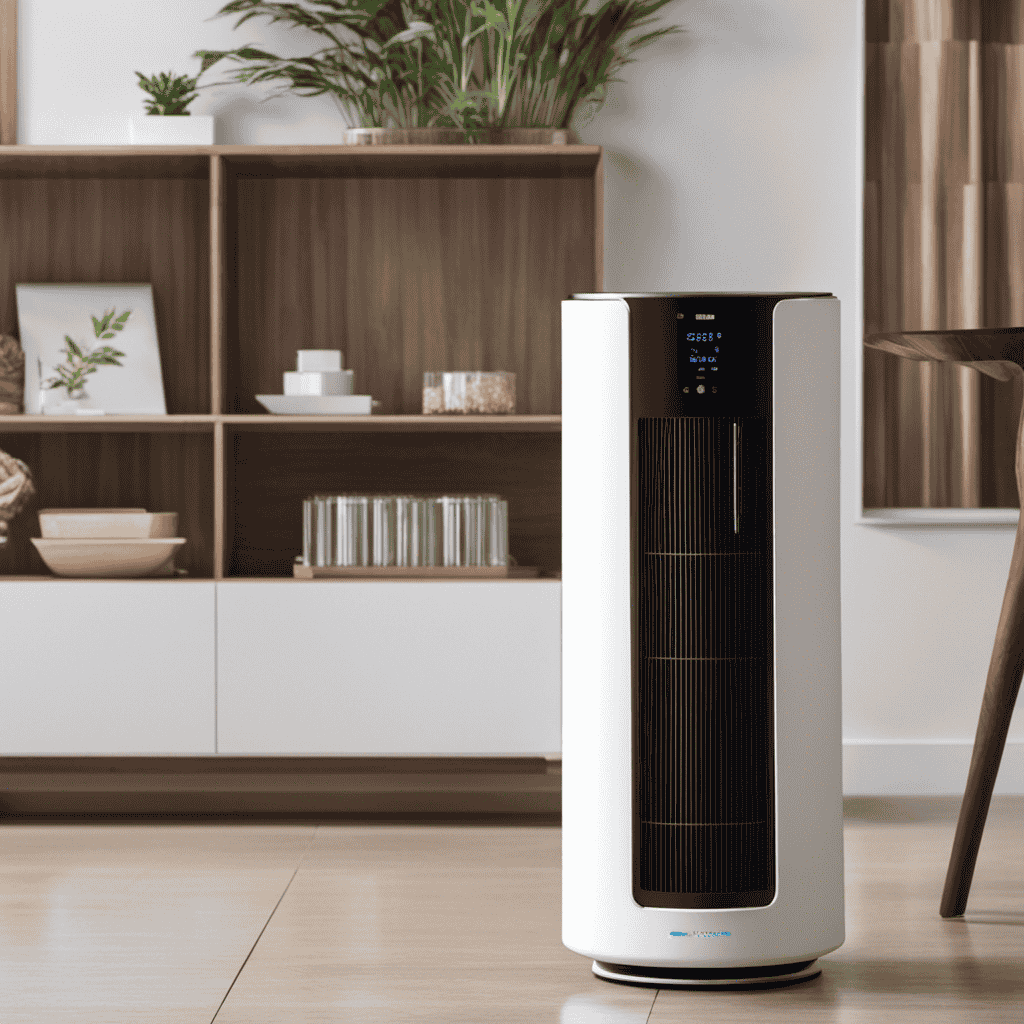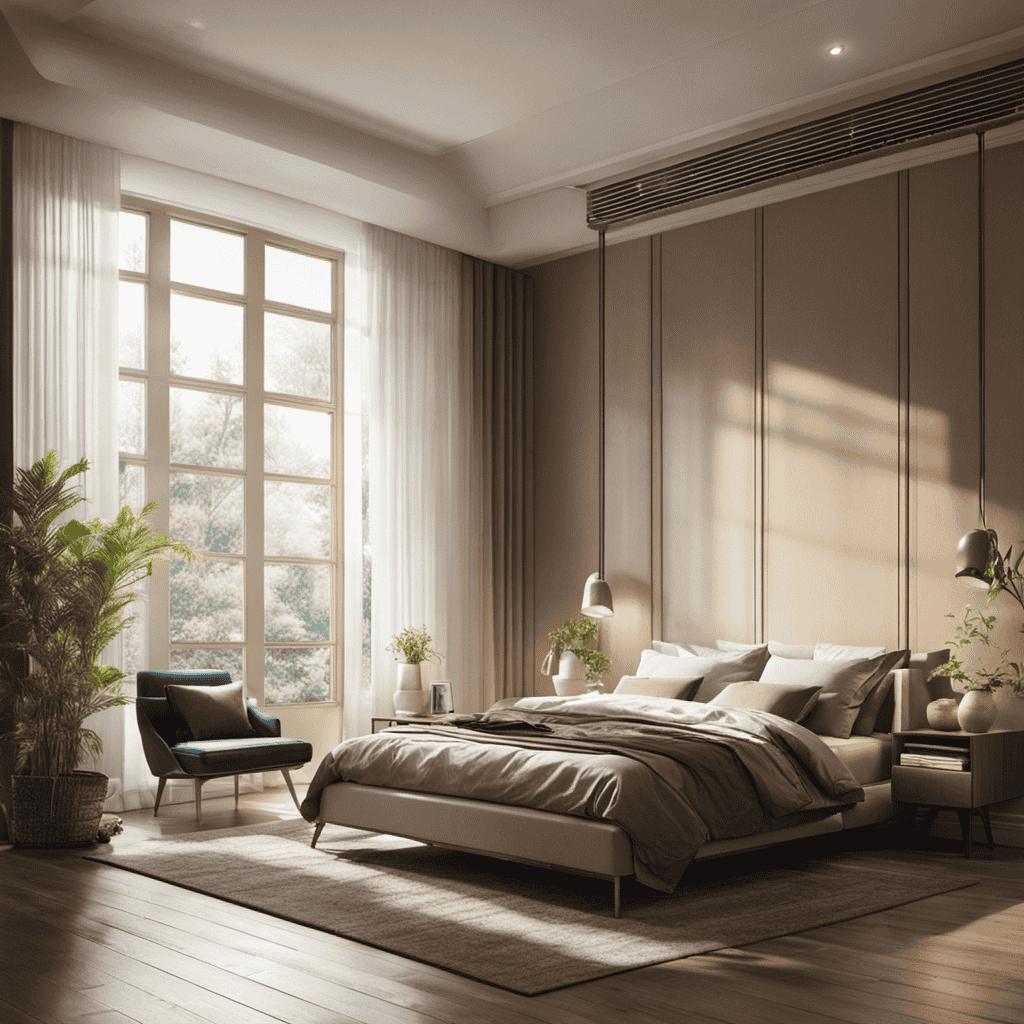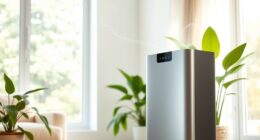As the old adage reminds us, ‘Pure air is crucial for maintaining good health.’ This is the reason I’m convinced that an air purifier in one’s home or workspace can be advantageous to all.
In this article, we will explore the numerous health benefits of air purifiers, from reducing common indoor air pollutants to alleviating allergies and asthma symptoms. We’ll also discuss how air purifiers can improve sleep quality, benefit pet owners, and create a healthier environment for children and babies.
Additionally, we’ll delve into the importance of air purifiers in office spaces. So, let’s dive in and discover who truly needs an air purifier.
Key Takeaways
- Air purifiers are beneficial for individuals with asthma and allergies, as they effectively remove airborne allergens and reduce allergy symptoms.
- Air purifiers improve respiratory health for asthma sufferers by reducing pollutants and minimizing the release of harmful particles into the environment.
- Pet owners can benefit from air purifiers as they help reduce pet dander and eliminate pet odors in the home, creating a healthier environment for both humans and pets.
- Scientific studies have shown that air purifiers with HEPA filters and activated carbon filters are effective in capturing and removing indoor air pollutants, improving overall indoor air quality.
Health Benefits of Air Purifiers
Air purifiers can help improve overall health by removing pollutants from the air we breathe. Indoor air pollution is a significant concern, as it can contain various harmful substances such as dust, pet dander, pollen, and volatile organic compounds (VOCs). These pollutants can have adverse effects on respiratory health, leading to symptoms like coughing, wheezing, and shortness of breath.
Scientific studies have shown that air purifiers can effectively reduce indoor air pollution and mitigate its impact on respiratory health. By utilizing filters and technologies like HEPA (High-Efficiency Particulate Air) filters and activated carbon filters, air purifiers can capture and remove these pollutants, providing cleaner and healthier air to breathe. This is especially beneficial for individuals with respiratory conditions such as asthma and allergies.
Transitioning to the next section, let’s now explore some common indoor air pollutants.
Common Indoor Air Pollutants
As I delve into the topic of common indoor air pollutants, I find it crucial to address three key points: harmful chemical fumes, dust and allergens, and mold and mildew.
These pollutants can have detrimental effects on our health, causing respiratory problems, allergies, and even long-term diseases.
Through scientific analysis and evidence-based research, we can better understand the impact of these pollutants and find effective ways to mitigate their harmful effects on our indoor air quality.
Harmful Chemical Fumes
Using an air purifier can help reduce the effects of harmful chemical fumes on your health. Chemical sensitivities are becoming more prevalent, and exposure to indoor air pollutants can have serious consequences for our well-being.
Indoor air quality is a crucial factor in maintaining a healthy living environment. Harmful chemical fumes can originate from various sources such as cleaning products, paints, solvents, and building materials. These fumes can trigger respiratory problems, allergies, and even contribute to the development of chronic illnesses.
Dust and Allergens
To effectively reduce the effects of dust and allergens on your health, it’s important to regularly clean and vacuum your living space. Dust and allergens, such as dust mites, can have a significant impact on respiratory health. Here are four reasons why regular cleaning and vacuuming are essential:
-
Dust mites thrive in warm, humid environments, and their waste products can trigger allergic reactions and worsen asthma symptoms.
-
Dust particles, including pollen and pet dander, can accumulate in your home and cause respiratory irritation.
-
Vacuuming with a HEPA filter can effectively remove dust and allergens from carpets, upholstery, and hard surfaces.
-
Regular cleaning can help prevent the buildup of dust and allergens, reducing the risk of respiratory issues.
Mold and Mildew
You should regularly check for signs of mold and mildew in your home, as they can negatively impact your respiratory health. Mold and mildew thrive in damp environments, making it crucial to take preventive measures to avoid water damage. By addressing leaks and condensation promptly, you can prevent the growth of these harmful substances. Mold and mildew release spores into the air, which can trigger allergies and respiratory issues such as coughing, wheezing, and difficulty breathing. The following table provides a comprehensive list of signs to look out for and preventive measures to take:
| Signs of Mold and Mildew | Preventive Measures |
|---|---|
| Musty odor | Fix leaks |
| Discoloration on walls | Control humidity |
| Peeling or bubbling paint | Proper ventilation |
| Allergic reactions | Regular cleaning |
Allergies and Air Purifiers
Allergies can be relieved by an air purifier. Air purifiers have been shown to have a positive impact on respiratory health, especially for those suffering from seasonal allergies.
Here are some key points to consider:
- Air purifiers can effectively remove airborne allergens such as pollen, dust mites, pet dander, and mold spores.
- By reducing the presence of these allergens in the air, air purifiers can help alleviate allergy symptoms such as sneezing, congestion, and itchy eyes.
- Studies have demonstrated that using air purifiers in homes and offices can significantly improve indoor air quality, leading to a reduction in allergy triggers.
- Air purifiers with HEPA filters are particularly effective at capturing allergens as small as 0.3 microns in size.
With the ability to remove airborne allergens, air purifiers provide a valuable tool in managing allergies.
Now let’s explore how air purifiers can also benefit individuals with asthma.
Asthma and Air Purifiers
Asthma sufferers may find relief from symptoms by using an air purifier. Air purifiers are designed to remove pollutants and allergens from the air, making it cleaner and safer to breathe. Research has shown that air purifiers can be effective in reducing asthma symptoms and improving respiratory health.
One study conducted in 2018 found that using a HEPA filter air purifier significantly reduced asthma symptoms in children. Another study in 2017 showed that air purifiers can reduce exposure to airborne pollutants, such as particulate matter and volatile organic compounds, which are known to trigger asthma attacks.
In addition to improving respiratory health, air purifiers also play a crucial role in reducing environmental pollution. By filtering out pollutants like smoke, dust, and pet dander, air purifiers help improve indoor air quality and minimize the release of harmful particles into the environment.
Benefits for Pet Owners
As a pet owner, I’ve often wondered how to reduce pet dander and eliminate pet odors in my home.
Through my research, I’ve discovered that there are effective methods for achieving both of these goals.
Reducing Pet Dander
If you want to reduce pet dander in your home, you should consider using an air purifier. Pet dander, which includes tiny skin flakes and saliva, can trigger allergies in some individuals.
Here are four reasons why an air purifier can help with pet hair control and pet-related allergies:
-
HEPA filtration: Air purifiers equipped with High-Efficiency Particulate Air (HEPA) filters can trap and remove pet dander particles as small as 0.3 microns.
-
Activated carbon filters: These filters can help eliminate pet odors by adsorbing volatile organic compounds (VOCs) released from pet urine and feces.
-
UV-C technology: Some air purifiers come with ultraviolet germicidal irradiation (UVGI) technology, which can kill airborne bacteria and viruses, reducing the risk of respiratory infections.
-
Ionizers: Air purifiers with ionizers can release negative ions that attach to pet dander particles, causing them to fall to the ground instead of remaining in the air.
By using an air purifier, you can effectively reduce pet dander and improve indoor air quality, providing a healthier environment for both you and your furry friend.
Now, let’s move on to the next section about eliminating pet odors.
Eliminating Pet Odors
To eliminate pet odors in your home, you can try using natural remedies like baking soda or vinegar. These substances have been proven to be effective in neutralizing unpleasant smells.
Baking soda works by absorbing odors, while vinegar acts as a natural deodorizer.
Simply sprinkle baking soda on carpets and upholstery, let it sit for a few hours, and then vacuum it up.
For small areas, you can mix equal parts vinegar and water in a spray bottle and mist the affected area.
However, it is important to note that these remedies may only provide temporary relief and may not completely eliminate pet odors.
In addition to using natural remedies, investing in pet-safe air purifiers can help remove pet hair and other allergens from the air, improving indoor air quality and reducing odors.
Air Purifiers for Smoke and Odor Removal
Air purifiers can effectively remove smoke and odors from indoor spaces. They are highly efficient in tackling various sources of indoor air pollution. Here are four key reasons why air purifiers are essential for smoke and odor removal:
-
Air purifiers for pet hair: Pets can shed a significant amount of hair, which can circulate in the air and trigger allergies. Air purifiers equipped with HEPA filters can capture pet hair and dander, improving indoor air quality and reducing potential health risks.
-
Air purifiers for cooking odors: Cooking odors can linger in the air, making it unpleasant for residents. Air purifiers equipped with activated carbon filters can effectively absorb and neutralize cooking odors, leaving the air fresh and clean.
-
Removal of smoke particles: Air purifiers with HEPA filters are highly efficient in trapping smoke particles, including those from cigarettes, wildfires, or cooking. This helps eliminate the harmful pollutants that can be detrimental to respiratory health.
-
Odor elimination: Air purifiers equipped with activated carbon filters can effectively eliminate odors caused by smoke, pets, cooking, or other sources. The carbon filters absorb and neutralize the odor molecules, leaving the air smelling fresh and clean.
Air Purifiers for Improved Sleep Quality
Investing in an air purifier can help me achieve better sleep quality by reducing allergens and pollutants that can disrupt my sleep. The quality of air in our bedrooms can have a significant impact on our sleep. Poor air quality can lead to respiratory issues and allergies, which can make it difficult to fall asleep and stay asleep throughout the night.
Air purifiers are designed to remove airborne particles such as dust, pet dander, pollen, and mold spores from the air, thus improving air quality and reducing respiratory issues. These devices use filters to trap and remove these particles, ensuring that the air we breathe while sleeping is clean and free of potential irritants.
Air Purifiers for Children and Babies
Using an air purifier can help create a healthier environment for children and babies. It reduces allergens and pollutants that can affect their respiratory health. Air purifiers are especially beneficial for these vulnerable populations as they have immature immune systems and are more susceptible to the harmful effects of indoor air pollution.
Here are four key reasons why air purifiers are essential for children and babies:
- Reduces exposure to airborne allergens such as dust mites, pet dander, and pollen.
- Removes pollutants like volatile organic compounds (VOCs) and tobacco smoke that can trigger respiratory issues.
- Helps prevent respiratory infections by eliminating bacteria, viruses, and mold spores from the air.
- Improves overall indoor air quality, promoting better sleep and cognitive development.
Furthermore, air purifiers can also be beneficial for other sensitive groups, such as the elderly and pregnant women. These individuals may experience respiratory discomfort or have compromised immune systems.
Transitioning to the next section, let’s explore the importance of air purifiers for office spaces.
Air Purifiers for Office Spaces
Transitioning to the topic of air purifiers in office spaces, it’s important to consider the benefits they provide for improving indoor air quality and employee well-being.
Air purifiers for home use have gained popularity in recent years due to their ability to remove pollutants and allergens from the air. However, their effectiveness in office spaces cannot be overlooked. Research has shown that air purifiers can significantly reduce the levels of airborne allergens and pollutants, making the workplace environment healthier for individuals with allergies and asthma.
By removing common triggers such as dust mites, pollen, and pet dander, air purifiers create a cleaner and safer environment, reducing the risk of allergic reactions and asthma attacks. This leads to improved employee well-being, productivity, and overall satisfaction.
Therefore, incorporating air purifiers in office spaces is a wise investment in creating a healthier and more comfortable work environment.
Frequently Asked Questions
How Long Does an Air Purifier Last Before It Needs to Be Replaced?
Air purifiers typically last for several years before needing to be replaced. Signs that indicate it’s time to replace an air purifier include decreased effectiveness in cleaning the air, strange noises, and a noticeable decrease in airflow.
Can Air Purifiers Remove Viruses and Bacteria From the Air?
Air purifiers are effective at removing viruses and bacteria from the air, providing numerous benefits for individuals concerned about indoor air quality. Their effectiveness is supported by scientific research and evidence-based studies.
Are There Any Potential Side Effects of Using an Air Purifier?
There may be potential health risks associated with using air purifiers, but their effectiveness in removing pollutants from the air outweighs these concerns. It is important to consider individual sensitivities and choose the right purifier for specific needs.
Do Air Purifiers Eliminate the Need for Regular Cleaning and Dusting?
Air purifiers do not eliminate the need for regular cleaning and dusting. While they can reduce airborne allergens, they are not as effective as vacuum cleaners in removing dust and dirt from surfaces.
Can Air Purifiers Help Reduce the Symptoms of Respiratory Illnesses Such as Bronchitis or Chronic Obstructive Pulmonary Disease (Copd)?
Air purifiers can help reduce allergy symptoms by improving indoor air quality. They filter out allergens such as dust, pollen, and pet dander, reducing their presence in the air and minimizing respiratory irritation.
Conclusion
In conclusion, after analyzing the health benefits of air purifiers and their effectiveness in removing common indoor air pollutants, it is evident that everyone should consider having one in their living spaces.
Just like a knight protecting a castle against invaders, air purifiers act as our defenders, safeguarding us from allergies, asthma triggers, pet dander, smoke, and unpleasant odors.
They enhance sleep quality, particularly for children and babies, and create a healthier environment in offices.
The evidence supports the notion that air purifiers are a valuable investment for our well-being.










